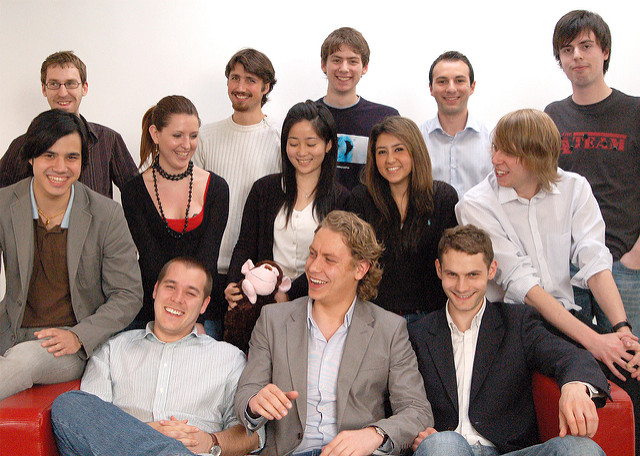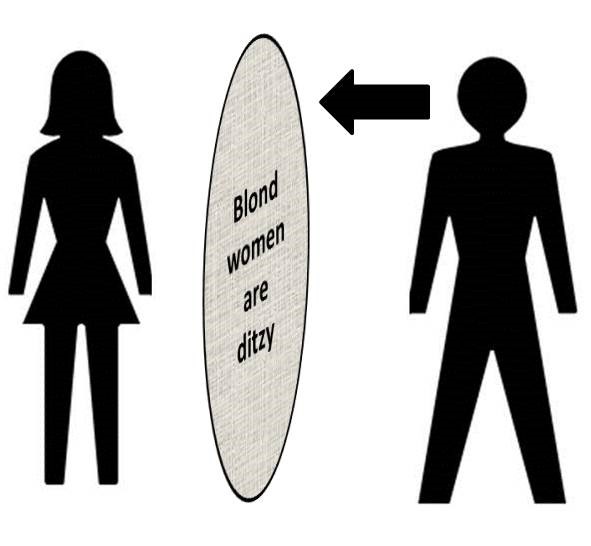Module II: PerceptionSection 2: The Perception ProcessAfter completing this section, students should be able to:
The perception process has three stages: sensory stimulation and selection, organization, and interpretation. Although we are rarely conscious of going through these stages distinctly, they nonetheless determine how we develop images of the world around us.
Sensory stimulation is self defining: our senses are bombarded by stimuli. We hear, touch, taste, see, or smell something. The neurological receptors associated with these senses are stimulated, and this stimuli races to the brain for processing. However, there is a problem. We cannot attend to all the stimuli we experience. Given the sheer quantity of sensory stimulation, we cannot pay attention to all of it. We must engage in sensory selection. Sensory selection is the process of determining which stimulus gets our attention and which stimuli we ignore. As with the rest of the perception process, rarely are we aware of this “weeding” process occurring, yet we must manage the sensory load.
An example of sensory selection is the “cocktail party effect.” When we attend a crowded party, with numerous conversations happening at once, we cannot adequately attend to several conversations simultaneously. Instead, we tune out extraneous sounds in favor of the person we wish to attend to. We select the most important stimuli to attend to, and we eliminate the rest (Hamilton, 2013). Another, somewhat unusual example, is clothing. Rarely are we very aware of how our clothes feel touching our bodies, yet there are countless sensory receptors being stimulated. Since the feel of our clothing is not typically very important, we simply ignore it. Yet if we change the situation, such as trying on a new pair of jeans to see if it they fit, we become much more aware of how those clothes feel. In effect, when trying on clothes prior to purchasing them, we are trying to determine if they are comfortable enough so we can weed out the stimuli of wearing them. So “comfortable” means, “I can ignore how they feel.” Wearing formal attire for a wedding, we may notice how odd the suit or the dress feels in comparison to our typical, daily attire. Because the situation has changed, it is more difficult to weed out the stimuli. As we experience a flood of stimuli, four factors influence what we pay attention to and what we ignore: 1. Needs. We pay far more attention to things which fill a need or requirement. When hungry, we are far more likely to notice places to eat. If we are not hungry, the restaurants, snack bars, and delicatessens are still there, but we do not pay attention to them as they are not meaningful to us at that time. If we need to get somewhere in a hurry, we become very conscious of slower drivers, stoplights, or other such hindrances we might otherwise ignore. All needs have an ebb and flow to it; as need rises, attention rises, but as needs are fulfilled, attention ebbs. Interest also allows us to perceive more detail in those things we experience. Intense football fans will see details of play development and
strategy casual fans may not recognize. The higher interest in the game leads the fan to learn more, and the more the fan learns, the more the fan can perceive. Devoted NASCAR racing fans see strategy and technique when watching a race; non-fans see a bunch of fast cars turning left. Interest not only drives us to pay attention to the stimuli, it also encourages us to learn more about it, and so we learn to see even more detail and specifics. A dancer who performs with the local Somali traditional music and dance group hears the nuances of the songs and sees the variety of steps in the dances; those new to this type of performance may only perceive people bouncing on the stage. This cycle applies in all facets of our lives. There are people who can discern every spice in a dish simply by tasting; there are musicians who can identify every instrument in a piece of music just by listening. As our knowledge of effective communication rises, we will be better attuned to the dynamics occurring in a given communication situation, so we will be able to more precisely identify what is or is not working. The danger of this dynamic, of course, is allowing expectation to override reality. Since the students expected to see the darker side of New York, they may have been blinded to the diversity and dynamic environment of the bustling city. If a student takes a class from a teacher assumed to be “boring,” the student may not even attempt to engage the material or be active in the classroom. If we expect to not experience something, we are less likely to “see” it. We do not expect our friends to treat us poorly, so we are less likely to notice behaviors others might consider rude or insensitive. The desire for affection and acceptance can often blind us to such things. A young man may not realize his girlfriend is taking advantage of him because he expects she would not treat him badly, even if his friends are trying to get him to see what is really going on. He does not expect to see evidence of her poor treatment so he, in effect, blinds himself to certain stimuli. 4. Physiological Limitations. Physiological limitations refer to basic sensory limitations; one or more of our senses is limited as to how well it will function. For those who wear glasses, the world is blurred without corrective lenses; what they can sense is very limited by a physical problem. Hearing losses, diminishment of taste and smell, and loss of touch sensitivity can all cause us to have limits on what we can experience. Many who have extreme physiological limitations often compensate by using other senses in a heightened manner. A man who is blind may attend to sounds at a much higher level than a sighted person, using those sounds as a mechanism for discerning his environment. A woman who is deaf may attend to visual cues at a much higher level than a hearing person for the same reason.
Once our senses have been stimulated, we move to the second stage of perception, organization. Organization is the process of taking the stimuli and putting it into some pattern we can recognize. As an analogy, when we come home from the grocery story with several bags, we sort those bags into the appropriate cabinets, organizing the items so their placement makes sense for later use. How we understand this process of organization comes from Gestalt theory. Gestalt is German for “pattern” or “shape,” and the theories address how we translate external stimuli into mental images. Developed in the early 20th century, Gestalt theory states how we process stimuli is a complex process blending external stimuli with internal processes (Rock & Palmer, 1990). In other words, how we perceive the external world is heavily determined by internal influences. There are four variables affecting how we organize the stimuli we encounter: 1. Patterns. Patterns are pre-existing "templates" we use to order stimuli. These are ways of organizing the stimuli that we have learned and carry with us. As children we are taught basic shapes, like "square," "triangle," and "circle," so when we experience a stimulus fitting those templates, we can make sense of what we see. Parents teach children what it means to be "rude" or "nice," so we learn to make sense of behavior by using these learned templates.
Consider Image 3. Most U.S. students will see patterns for each of the top three strings of numbers. The top one fits a standard telephone number for us in the U.S. The next fits the number pattern for a U.S. Social Security number, and the third fits the pattern for a credit card number. The last two, however, may be not be immediately apparent, yet they are commonly recognized patterns in other parts of the world. One is a Costa Rican phone number and a Scottish phone number. Of course, unless we have these templates already in place from our past experiences, we would not discern those patterns. Only because of the templates we have learned will we see these patterns, otherwise they would be just a list of random numbers.
We are always expanding our storehouse of templates. Every time we learn something new, we have created new ways of organizing stimuli. As we learn new words, each word is a new template for that set of sounds or visual shapes. Image 4 is a Mobius Strip. Often used to represent infinity, the ribbon turns so that there is no identifiable inside, outside, up, or down. Once we learn the pattern for “Mobius Strip,” when we see one in the future we are more likely to recognize it. We have learned a new pattern.
As discussed with sensory stimulation, the more of an interest we have in something, the more we learn about it, so that means we learn more and more patterns for that subject. Thus, when we experience something in an area of interest, we can discern more detail as we have more patterns to apply.
2. Proximity. Proximity refers to how we see one object in relation to what is around it. We do not just see a person; we see the person within their surroundings which affects our interpretation of that person. A specific dynamic of proximity is the figure-ground relationship. The figure-ground relationship posits that as our focus on the object (the figure) and the background (the surroundings) change, interpretation changes. In applying the concept of figure-ground to people, consider professors. Seeing a professor on campus is unremarkable; we think little of it. If, however, we see them late at night coming out of a bar with a questionable reputation, our perception may be altered based on seeing them in that background. Politicians are very aware of this dynamic, avoiding backgrounds that may cause problems. A politician does not want to be seen in a strip club but does want to be seen in church. When the President visits Minnesota, politicians of that party may scramble to be seen with him, while politicians of the opposing party may make a point of staying away. Seeing a young adult with a backpack on the Ridgewater College campus would undoubtedly be interpreted as "student." Seeing that same person with a backpack at a shopping mall, however, does not automatically lead to the same conclusion due to the differences in proximity.
3. Simplicity. As we now know, we are driven to lower uncertainty and make sense of the world around us. In lowering uncertainty, we tend to favor the easiest, least confusing perception of a person or event; we like simple perceptions. First impressions are so powerful because once we have created an initial perception, it is far simpler to keep it than change it. It is hard for us to change our perceptions because changing our minds causes complexity, and the drive for simplicity is a powerful, countering force. While a normal process, this drive for simplicity can be dangerous. We can be guilty of oversimplifying complex issues. An anthem of the Sixties was “All You Need is Love,” a 1967 Beatles song written by John Lennon specifically for the first live, global television broadcast (Harrington, 2002). While such sentiments are admirable, the issues facing the world are far more complex. We still see the same drive to take very complex issues and narrow them down to simple solutions. Effective problem solving means identifying the underlying causes, effects, and consequences of a given issue. If we do not acknowledge and work with that complexity, we risk dramatic failures. For example, the U.S. has made efforts to bring democracy to countries dominated by conservative religious groups, such as the Taliban in Afghanistan. Some simplistically assume that since secular democracy works here in the U.S., it will work everywhere. However, in the U.S. we are very comfortable with the separation of church and state, but in some countries, the two are so intertwined they cannot be separated; the church is the state. United States’ efforts to create a secular government fail as the complexities of that culture are not adequately considered. Part of understanding the complexities involved lies in recognizing that culture is visible (clothes, skin color, food) and invisible (values, beliefs, attitudes), both of which are expressed through behavior. Communicating effectively with complex cultures and individuals requires us to accept complexity and to resist over-simplifying. This drive to simplicity affects how we perceive individuals. The power of stereotyping is simplicity. Stereotypes are generalizations about a group of people categorized by an external marker, like sex, and skin color. Having one way of looking at an entire group is much simpler than treating each member of that group as an individual with a unique personality. It is far simpler to assume that “all blonds are dumb” or “all students are lazy” than to let each individual blond or each individual student emerge as a unique person. Individual perception takes time and effort; group stereotyping is easy. Stereotyping is a simplistic way of perceiving the world around us. We can see this simplicity at work in popular culture with something called type-casting. In selecting actors for a TV show or movie, it is common that stereotypes come into play. Actors are often cast on their ability to reflect stereotypical representations of different character types. According to Reactions to Counterstereotypic Behavior: The Role of Backlash in Cultural Stereotype Maintenance,
In other words, the use of stereotypes as guidelines for how characters are to be portrayed is seen as more favorable than portraying a character in non-stereotypical ways. We see portrayals of Arabs as either oil billionaires or terrorists; or in the news about a natural disaster in Mexico, the locals are shown as patient and passive, and in need of help from America. African American women used to be portrayed as domestics but now are more likely to be seen in the background as a homeless person, a prostitute, or an angry black woman. Asian Americans are shown as academically gifted or as without friends, and not much else. Caucasions do not escape the broad brush of stereotypes in the media; they may be likewise type cast as the clueless father, the dizzy, frantic mother, or the spoiled child. As these stereotypes fill our televisions and stream to our electronic devices, they reinforce the existence of the stereotype in a powerful cycle.
4. Closure. Closure is the psychological drive for completeness. Again, with our powerful need to lower uncertainty, it is much more comfortable to perceive a whole, complete picture than partial images that do not seem to make sense. As a result, we will fill in missing stimuli to make the incomplete appear whole. While Image 9 may look like the word THE, note that the letters T, H, and E are not fully present. Instead, due to the proximity of the lines to each other, it is simpler to imagine the missing lines to see a whole word than leaving it as a collection of unrelated lines. In fact, in years of using this example, native English-speaking students always see the word THE. In applying this to people, if a friend does or says something unusual, we will create an explanation that at least temporarily explains what happened. It may not be correct, but being right is not as important as lowering uncertainty. For example, Ashley, whom we think is very open-minded, tells a racist joke. This creates uncertainty in us as it is so out-of-character for Ashley. We will try to determine why she did such a thing, trying to make sense of the inconsistent behavior. We may think, “She didn’t realize how racist that is,” or “She’s being sarcastic.” Until we can ask Ashley directly, we rely on these assumptions to explain the inconsistency and lower the uncertainty. Engaging in closure, while perfectly natural, also can be dangerous. For some, once they fill in the missing information, they will take it as fact, not supposition. Their assumption becomes a false reality. The number of interpersonal conflicts caused by what we assume about the other is staggering.
Consider Image 10, what might most assume about this person? Although we know virtually nothing about her, other than what we see in front of us, we immediately have a list of assumptions about this person. And in today’s digital world, we cannot even be confident the image is real, as the photograph may be heavily manipulated.
After sensing the stimuli and organizing it into something recognizable, we attach a label; we interpret it. The interpretation stage is where we make sense of what we have experienced; we determine what it means to us. From the communication model, we know how we interpret input is determined by our field of experience; we learn how to see the world. There are a number of processes impacting how we interpret the stimuli. 1. Implicit Personality Theories: In 1954, psychologists introduced the concept of implicit personality theories, suggesting that we do not learn a person’s traits one at a time; rather, we see them in “groups” (Schneider, 2004, p. 173). Social Psychologist Solomon Asch found that the presence of one trait led people to assume the presence of other traits (McLeod, 2008). When we see one trait, such as gender, we make all sorts of assumptions as what the person is like; we assume the presence of trait A implies the presence of traits B, C, D, and so on. Two types of implicit personality theories are the halo effect and stereotyping. The halo effect is our belief that traits tend to cluster, that traits “naturally” appear in groups. We tend to assume certain traits just normally go together; once we experience one trait, we assume other traits just fall into place: “It is the idea that global evaluations about a person (e.g. she is likeable) bleed over into judgments about their specific traits (e.g. she is intelligent)” (Psyblog, 2007). This is most noticeable with attractiveness. As Asch discovered, we tend to assume those we see as “attractive” have multiple, positive traits, whether we have directly experienced them or not, and for those we find unattractive, we tend to assume multiple, negative traits. Obviously, our perceptions could be very far off in such a process. Remember the influence of expectations on sensory selection; we are more likely to see what we expect to see. Considering the influence of simplicity, it is far simpler to cluster traits than to allow for a rich diversity of personality types. As a result of these perceptual influences, this tendency to cluster traits is quite strong and can be challenging to counter.
Stereotyping is a more extreme type of implicit personality theory. While the halo effect links traits to each other, stereotyping links traits to people. Stereotyping is the association of traits with a group of people usually categorized by an external marker. We group people most often by some trait we can observe, such as gender, race, skin color, weight, height, or hair color, and then, we assume what we think is true of that group is true of each individual. If Doug believes the stereotype, “All blond females are dumb,” he is using two external markers, “blond,” and “female.” When he sees a blond female, he assumes she is dumb regardless of what she is really like. Doug sees two traits, and then he assumes other traits based on those external markers. Our assumptions dictate what a person is like rather than drawing our image of them from actual experience. As illustrated in image 11, stereotypes place themselves between us and the other person, severely distorting our perception of the other. 2. Assumed Similarity/Assumed Dissimilarity. When first meeting people, we make a very quick assessment of how similar or different we are. We see similarities or differences in gender, age, body size, demeanor, dress and other such superficial features. If Megan's initial assessment is that she is similar to Lindsey, she will assume they share many traits beyond these; Megan assumes similarity. If her initial assessment is they are different, Megan will assume what is true of her is not true of the other; she assumes dissimilarity. It is important to emphasize that these are still our internal assumptions based on very limited information, and that we may very well be wrong in our perceptions. Assumed similarity/dissimilarity is quite noticeable in attraction. Juan sees a girl, Magdalena, to whom he is quite attracted. In an effort to connect with her, Juan will focus on what he and Magdalena have in common, even if it means ignoring obvious differences. Juan assumes similarity with Magdalena in order to encourage the relationship. On the other hand, if Magdalena finds Juan annoying, she will emphasize dissimilarity to discourage the relationship, even if it means ignoring obvious similarities. 3. Self-fulfilling Prophecies. A self-fulfilling prophecy has three stages: prediction, action, and verification. We predict something. We then act, often unconsciously, in a manner that makes it come true. Once it comes true, we have then verified our prediction. If Sterling says to himself, "I can't pass the test," he is less likely to study. This inadequate preparation leads Sterling to fail, thus verifying the initial prediction. If Lee decides to go with his girlfriend to see what he thinks is a "chick flick," he may very well go into the theatre with the assumption, "This movie will be stupid, and I will not enjoy it." Lee will then tend to focus on anything he sees as “stupid,” reinforcing his initial assumption. Because he focused on parts of the movie fulfilling his prediction, Lee ends up experiencing a "stupid" movie in his mind. If a student has a firmly held expectation about an instructor being boring, they are more likely to look for evidence the teacher is boring instead of allowing their perception of the instructor to be based on what the teacher actually does in the classroom. Self-fulfilling prophecies distort perceptions by distorting our focus. 4. Perceptual Defense. Perceptual defense is our drive to maintain existing or strongly desired interpretations. The power of simplicity tells us that changing interpretations can be very discomforting. We do not like to change how we look at something, especially when the required change is from a comfortable, less troubling interpretation to a more troubling one. The first step for a person to seek help for alcoholism is to change their self-perception from "I don't have a problem" to "I do have a problem." This is a very difficult and disconcerting perceptual shift, and accordingly it is a challenging first step in seeking help. Our tendency to look for evidence supporting what we want to be true is confirmation bias. Confirmation bias is our tendency to emphasize and attend to evidence that supports conclusions we favor, and conversely our tendency to minimize and ignore evidence that is contrary to our desired perceptions (RationalWiki, 2013). If Aila does not want to accept that her son, Rashid, is a bully and trouble-maker at school, she will reject, minimize, or dismiss any evidence the school presents her supporting that view. Since it is more comfortable to maintain the perception that Rashid is a good student, she defends her perception by discounting the evidence that questions her viewpoint. Parents do not like to see their children having trouble socially or physically, but if they do not shift their perception and acknowledge reality, they will not be driven to seek help for their child. As our parents age, we do not wish to see them beginning to fail physically or mentally. We do not like to see our loved ones moving toward death, yet if we do not acknowledge those changes, we cannot take measures to aid our parents in their advanced years. With the advent of the internet, we have seen a dramatic growth in the tendency of people to exist in an echo chamber to fulfill their confirmation biases (DiFonzo, 2011). An echo chamber is a virtual space in which we receive only information which confirms positions and beliefs we prefer. In the 2012 election, many Republicans were taken aback by the loss of Mitt Romney to Barack Obama. After the election, some suggested the reason they were surprised is they were getting all of their news and information from conservative information sources, like Fox News, World News Daily, and other heavily biased sources. To maintain audience ratings, these sources would only report information the audience wanted to hear, information that confirmed their bias. When the election results came in, many were simply not aware of the support for Obama as their sources had not reported that information, or at least had done so in a distorted way. Limiting oneself to an echo chamber can happen with any group anywhere on a value spectrum, and the internet has made living in such echo chambers extremely easy. 5. Social pressure. Acceptance and belongingness are fundamental human drives. One way to meet these needs is to share perceptions. In the 1950s, Solomon Asch found that in many instances, we will conform to perceptions different than our own, at least temporarily, to avoid threats to our sense of acceptance (McLeod, 2008). We will tend to laugh along with others, even if we are not exactly sure what is funny. As we talk to our friends, we naturally share how we see the world, they share how they see the world, and we tend to adapt to each other. A reference group of five high school guys will have very similar interpretations of what it means to be "cool," what it means for a girl to be attractive, and what movies or music are good. Of course, this holds true for female groups or mixed gender groups as well. When confronted with the choice of having a different perception and risking acceptance, or having a similar perception and enhancing acceptance, we often gravitate to the shared perception. Actions based on this drive for acceptance is commonly called herd mentality. Dr. Conlin Torney of the University of Exeter explains:
As with other perceptual processes, the danger with social pressure and a herd mentality is not realizing how our personal beliefs, values, and behaviors may be compromised. We may act in ways that, upon reflection, are inconsistent with long-held beliefs. For example, a common issue for new college students is balancing finding a place of acceptance and inclusion on campus without giving in to social pressures to act in uncomfortable ways such as drinking alcohol. Sometimes the conflict of social pressures to drink and one’s personal belief in moderation becomes quite strong and can lead to some compromising decisions.
The terms and concepts students should be familiar with from this section include: Sensory Stimulation and Selection
DiFonzo, N. (2011, April 22). The echo-chamber effect. The New York Times. Retrieved from
http://www.nytimes.com/roomfordebate/2011/04/21/barack-obama-and-the-psychology-of-the-birther-myth/the-echo-chamber-effect
Hamilton, J. (2013, March 6). Hear that? In a din of voices, our brains can tune in to one. National Public Radio, Retrieved from http://www.npr.org/blogs/health/2013/03/07/173613681/hear-that-in-a-din-of-voices-our-brains-can-tune-to-one.
Harrington, R. (2002, November 24). His musical notes have become TV landmarks. Washington Post. p. Y06. Retrieved from http://player.interactual.com/news/McCartney.htm
McLoed, S. (2008). Asch experiment. Simply Psychology. Retrieved from http://www.simplypsychology.org/asch-conformity.html
Psyblog (2007). The halo effect: when your own mind is a mystery. Retrieved from http://www.spring.org.uk/2007/10/halo-effect-when-your-own-mind-is.php
RationalWiki, (2013). Confirmation bias. Retrieved from http://rationalwiki.org/wiki/Confirmation_bias
Rock, I., & Palmer, S. (1990, December). The legacy of Gestalt psychology. Scientific American, 263(6), 84-90.
Rudman, L.A., & Fairchild, K. (2004). Reactions to counterstereotypic behavior: The role of backlash in cultural stereotype maintenance. Journal of Personality and Social Psychology, 87(2), 157-176. DOI: 10:1037/0022-3514.87.2.157
Schneider, D. (2004). The Psychology of Stereotyping. New York: Guilford Press.
Williams, J.D., Henderson, G. R., & Harris A.M. (2001, November/December). Consumer racial profiling: bigotry goes to market. The New Crisis, 108(6), 22-24. Retrieved from
https://www.questia.com/magazine/1P3-107121129/consumer-racial-profiling-bigotry-goes-to-market
University of Exeter. (2014, December 16). Herd mentality: Are we programmed to make bad decisions?. ScienceDaily. Retrieved from www.sciencedaily.com/releases/2014/12/141216212049.htm
| |||||||||||||||||||||||||||
|
|||||||||||||||||||||||||||











